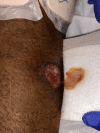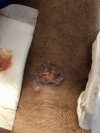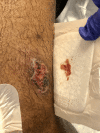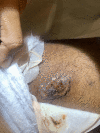A Difficult-To-Diagnose Case of American Tegumentary Leishmaniasis
- PMID: 37701165
- PMCID: PMC10493468
- DOI: 10.7759/cureus.44971
A Difficult-To-Diagnose Case of American Tegumentary Leishmaniasis
Abstract
This case report presents a difficult-to-diagnose case of American tegumentary leishmaniasis (ATL) caused by Leishmania (Viannia) guyanensis in a 24-year-old Hispanic male with a travel history to the Panama jungle, an endemic region for tropical infectious diseases. The patient initially presented with persistent skin lesions that progressed to abscesses with ulceration. Despite negative initial diagnostic tests, including microbiological investigations and histopathological examination, a comprehensive diagnostic workup and subsequent polymerase chain reaction (PCR) confirmed the presence of Leishmania parasites. This case underscores the need to consider tropical infectious diseases despite initial negative tests. Accurate species identification is vital for proper drug treatment, with miltefosine as an emerging option. Early, precise diagnosis and tailored management are essential for successful treatment. This report emphasizes the significance of conducting a comprehensive diagnostic workup, including PCR, in individuals with a history of travel to endemic regions, to accurately diagnose and effectively manage complex infectious diseases.
Keywords: american tegumentary leishmaniasis; cutaneous leishmaniasis; infectious disease diagnosis; infectious disease medicine; leishmania guyanensis; medical and diagnostic microbiology; skin eruptions; skin infections; skin ulcer; visceral leishmania.
Copyright © 2023, Khoury et al.
Conflict of interest statement
The authors have declared that no competing interests exist.
Figures
Similar articles
-
First Molecular Report of Leishmania (Leishmania) amazonensis and Leishmania (Viannia) guyanensis in Paraguayan Inhabitants Using High-Resolution Melt-PCR.Am J Trop Med Hyg. 2019 Oct;101(4):780-788. doi: 10.4269/ajtmh.18-0880. Am J Trop Med Hyg. 2019. PMID: 31407656 Free PMC article.
-
Field Validation of SYBR Green- and TaqMan-Based Real-Time PCR Using Biopsy and Swab Samples To Diagnose American Tegumentary Leishmaniasis in an Area Where Leishmania (Viannia) braziliensis Is Endemic.J Clin Microbiol. 2017 Feb;55(2):526-534. doi: 10.1128/JCM.01954-16. Epub 2016 Dec 7. J Clin Microbiol. 2017. PMID: 27927916 Free PMC article.
-
Polymorphism-specific PCR enhances the diagnostic performance of American tegumentary leishmaniasis and allows the rapid identification of Leishmania species from Argentina.BMC Infect Dis. 2012 Aug 15;12:191. doi: 10.1186/1471-2334-12-191. BMC Infect Dis. 2012. PMID: 22894734 Free PMC article.
-
American tegumentary leishmaniasis in Brazil: a critical review of the current therapeutic approach with systemic meglumine antimoniate and short-term possibilities for an alternative treatment.Trop Med Int Health. 2019 Apr;24(4):380-391. doi: 10.1111/tmi.13210. Epub 2019 Feb 19. Trop Med Int Health. 2019. PMID: 30681239 Review.
-
Leishmania (Viannia) guyanensis in tegumentary leishmaniasis.Pathog Dis. 2018 Jun 1;76(4). doi: 10.1093/femspd/fty025. Pathog Dis. 2018. PMID: 29722820 Review.
Cited by
-
Instrument-Free Point-of-Care Diagnostic for Leishmania Parasites.Diagnostics (Basel). 2024 Dec 5;14(23):2744. doi: 10.3390/diagnostics14232744. Diagnostics (Basel). 2024. PMID: 39682651 Free PMC article.
References
-
- Cutaneous leishmaniasis: immune responses in protection and pathogenesis. Scott P, Novais FO. Nat Rev Immunol. 2016;16:581–592. - PubMed
-
- Epidemic visceral leishmaniasis in southern Sudan: treatment of severely debilitated patients under wartime conditions and with limited resources. Seaman J, Mercer AJ, Sondorp HE, Herwaldt BL. Ann Intern Med. 1996;124:664–672. - PubMed
Publication types
LinkOut - more resources
Full Text Sources




